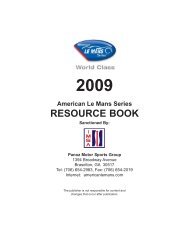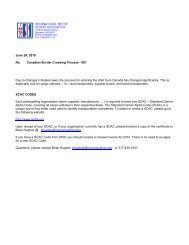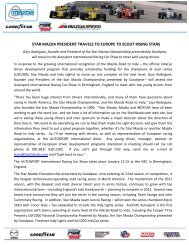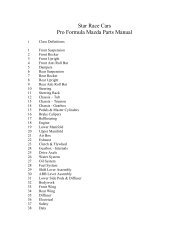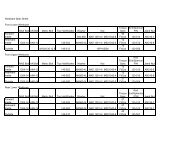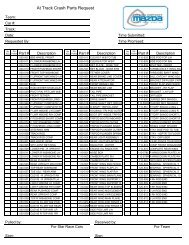Create successful ePaper yourself
Turn your PDF publications into a flip-book with our unique Google optimized e-Paper software.
83 Carbon Metallic Highway • Clover, SC • 29710 • Tel: 803-222-2141 • Fax: 803-222-8134<br />
www.performancefriction.com<br />
Balance bar set-up and technical notes<br />
Purpose:<br />
The function of a balance bar is to allow the adjustment of brake line pressure distribution between<br />
two master cylinders. This is accomplished through moving the balance bar pivot towards one<br />
master cylinder or the other. If the pivot is perfectly centered between the pushrods, the force applied<br />
to each master cylinder will be equal. This is known as the “neutral position” of the bias adjuster. If<br />
the pivot is moved closer to one master cylinder or the other, then the master cylinders will receive<br />
differential forces that are inversely proportional to the distance between the balance bar pivot point<br />
and master cylinder center lines. Being able to move the pivot point allows the driver to make<br />
incremental adjustments to the braking characteristics of the car (front-to-rear brake bias) and to alter<br />
those characteristics to account for changes in fuel load, track conditions and handling of the car.<br />
Pedal Assembly Types<br />
There are 2 types of brake pedal assemblies in common usage today. The traditional type, and by far<br />
the most common, is the “push-type” or “compression” pedal assembly. In this type of pedal, the<br />
brake master cylinder pushrods are actuated and push the piston into the body of the master cylinder.<br />
The pressure outlet is mounted on the opposite end of the master cylinder body from the pushrod.<br />
The second option, which is become more prevalent recently, is the “pull-type” or “tension” pedal<br />
assembly. In this type of pedal assembly, the master cylinder piston is pulled through the master<br />
cylinder body by the master cylinder pull rod. To accomplish this, the piston pull rod assembly is 1-<br />
piece. The pressure outlet for the master cylinder is located on the pull rod side of the piston in the<br />
master cylinder body. This type of pedal assembly is typically found in high-end racecars such as F1,<br />
but has gained favor in all types of racing due to much reduced hysterisis.<br />
Setting Up the <strong>Brake</strong> Balance Bar: Push Type<br />
The brake balance bar is one of the most overlooked, and least<br />
understood, components on a racecar. As with all aspects of racecar<br />
assembly and preparation, careful attention to the geometry of the<br />
brake balance bar and brake pedal will yield great benefits. To start<br />
with, look for proper installation of the brake balance bar bias<br />
adjuster and ensure that the brake balance bar pivot bearing is free<br />
to move within the threaded trunion. There are important installation<br />
and maintenance considerations for the push type pedal assembly.<br />
The articulating push type pedal assembly (wherein the master<br />
cylinder is mounted through a spherical joint), there are numerous spherical bearings, rod ends,<br />
clevises and needle bearings in these systems. These components must be in proper working order<br />
and clean of debris and dirt to function properly. Any excess play in these components will adversely<br />
affect the control and release of the brake system, and should be avoided at all costs.



